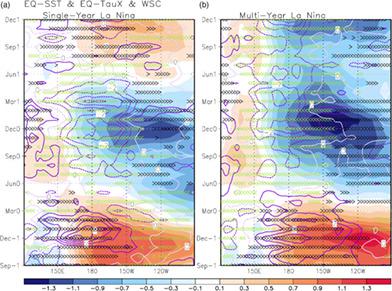当前位置:
X-MOL 学术
›
Int. J. Climatol.
›
论文详情
Our official English website, www.x-mol.net, welcomes your
feedback! (Note: you will need to create a separate account there.)
Mid‐latitude leading double‐dip La Niña
International Journal of Climatology ( IF 3.5 ) Pub Date : 2020-07-27 , DOI: 10.1002/joc.6772 Jae‐Heung Park 1 , Soon‐Il An 2 , Jong‐Seong Kug 1, 3 , Young‐Min Yang 4 , Tim Li 5 , Hyun‐Su Jo 6
International Journal of Climatology ( IF 3.5 ) Pub Date : 2020-07-27 , DOI: 10.1002/joc.6772 Jae‐Heung Park 1 , Soon‐Il An 2 , Jong‐Seong Kug 1, 3 , Young‐Min Yang 4 , Tim Li 5 , Hyun‐Su Jo 6
Affiliation

|
Understanding the evolution asymmetry between El Niño and La Niña events is challenging. Unlike El Niño, most La Niña events are characterised by a double‐dip cooling (a.k.a. multi‐year La Niña). Herein, we examined how single‐ and multi‐year La Niña events differ by analysing observational and climate‐model data sets. Single‐year La Niña events tend to develop narrowly within the tropics from a central Pacific‐type El Niño (Niño‐4 > Niño‐3), whereas multi‐year La Niña events tend to originate from an eastern Pacific‐type El Niño (Niño‐3 > Niño‐4) and are well‐connected to mid‐latitudes through the Pacific meridional mode, which leads to a meridionally wider response of the off‐equatorial low‐level atmospheric anti‐cyclonic circulation. As the anti‐cyclonic circulation controls the amount of equatorial upper‐ocean heat recharge through Sverdrup transport, for single‐year La Niña, efficient ocean recharging due to a narrower anti‐cyclonic circulation causes a fast transition to an El Niño or a fast termination of a La Niña. In contrast, for multi‐year La Niña, a weaker recharging causes surface cooling to persist, leading to another La Niña in the following year.
中文翻译:

中纬度领先的双倾LaNiña
了解厄尔尼诺事件和拉尼娜事件之间的进化不对称性具有挑战性。与厄尔尼诺不同,大多数拉尼娜事件的特征是双降温(又称多年拉尼娜)。在这里,我们通过分析观测和气候模型数据集,研究了单年和多年的拉尼娜事件有何不同。一年一度的拉尼娜事件倾向于在热带地区从太平洋中部的厄尔尼诺(Niño-4>Niño-3)狭窄地发展,而多年期的拉尼娜事件则倾向于从东太平洋型的厄尔尼诺(ElNiño)( Niño-3>Niño-4),并通过太平洋子午线模式与中纬度紧密相连,这导致了赤道外低空大气反气旋环流的子午线响应。由于反气旋环流通过Sverdrup输送控制赤道上层海洋的热量补给,因此对于单年的拉尼娜而言,由于反气旋环流较窄而导致的有效海洋补给会导致快速过渡至厄尔尼诺现象或迅速终止拉尼娜 相反,对于多年的拉尼娜来说,较弱的充电会导致表面冷却持续存在,从而在第二年又导致了拉尼娜现象。
更新日期:2020-07-27
中文翻译:

中纬度领先的双倾LaNiña
了解厄尔尼诺事件和拉尼娜事件之间的进化不对称性具有挑战性。与厄尔尼诺不同,大多数拉尼娜事件的特征是双降温(又称多年拉尼娜)。在这里,我们通过分析观测和气候模型数据集,研究了单年和多年的拉尼娜事件有何不同。一年一度的拉尼娜事件倾向于在热带地区从太平洋中部的厄尔尼诺(Niño-4>Niño-3)狭窄地发展,而多年期的拉尼娜事件则倾向于从东太平洋型的厄尔尼诺(ElNiño)( Niño-3>Niño-4),并通过太平洋子午线模式与中纬度紧密相连,这导致了赤道外低空大气反气旋环流的子午线响应。由于反气旋环流通过Sverdrup输送控制赤道上层海洋的热量补给,因此对于单年的拉尼娜而言,由于反气旋环流较窄而导致的有效海洋补给会导致快速过渡至厄尔尼诺现象或迅速终止拉尼娜 相反,对于多年的拉尼娜来说,较弱的充电会导致表面冷却持续存在,从而在第二年又导致了拉尼娜现象。











































 京公网安备 11010802027423号
京公网安备 11010802027423号